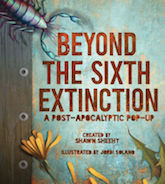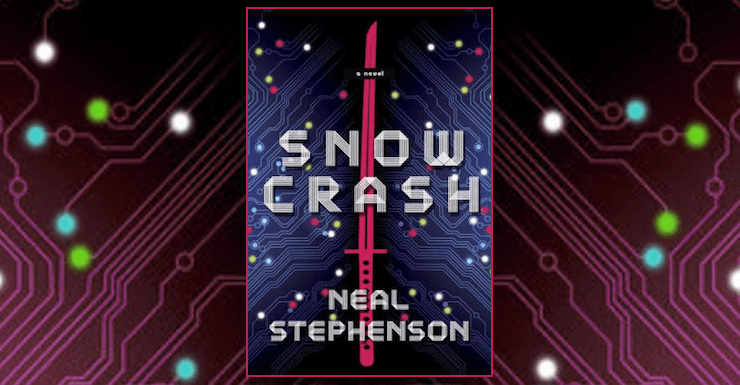I first read Snow Crash in the late ‘90s, probably over a summer during my grad school years. I was earning an MFA in the Book and Paper Arts, and I was geeking out over the history of the book, the moment in history when oral languages were codified into written languages, and the processes by which written words were accumulated and stored as texts. This history begins with the writing system known as Sumerian cuneiform, composed of characters pressed into clay tablets. There could not have been a better time for me to read this novel.
Snow Crash gets its name from the virus that is central to the action of this Neal Stephenson novel. This virus has dual forms; a biological blood-born pathogen, and a technological bug that infects computers and brains with equal virulence.
Stephenson traces his virus’s origins to ancient Sumer. There, the goddess Asherah sought to control the Sumerians through a brainwashing strategy that combined this virus with the common language of Ur. The god/hero Enki thwarted Asherah’s mind control plans with what Stephenson calls a nam-shub; alternative languages that he released into the population. The Sumerians were no longer able to communicate with each other, the transmission of the language/virus was stopped in its tracks, and, incidentally, the myth of the Tower of Babel was born.
In the “now” of Stephenson’s novel, Asherah’s language/virus is revived for deployment; this time by a Christian fundamentalist sect leader named L. Bob Rife. The virus maintains its relationship with language, but the package is expanded to include computer code. The virus can operate in the technological realm, and it becomes possible to contract the virus—and brainwashed into a slack-jawed follower of Rife—simply by seeing the manifestation of its code on a computer screen. Rife’s plot is thwarted by the hero/protagonist named Hiro Protagonist (sometimes you have to call it like you see it). Like Enki did 8,000 years earlier, Hiro releases a nam-shub and saves the world from evil domination.
I attended grad school at a time when there was little post-secondary instruction in the book arts. As a burgeoning field of study, much discussion was given to its relevance. If book making was an ancient practice, why was it only now arriving in art departments at contemporary graduate schools? It’s possible that the answer to this question lies largely in the digitization of the word. As text consumption became more of a screen activity, the sensuality of the printed experience was diminished. The book lovers of the world read the writing on the wall and decided that bookmaking skills needed to be preserved in academia. Though the word-smithing was the same as always, the paper making, the printing, and the binding—especially in the context of a deluxe approach to craft—were migrating from the commercial world to the fine art world.
It’s possible that Stephenson intended for us to read Snow Crash at least in part as metaphor. His reintroduction of the Sumerian virus into his modern world could have been his way of comparing the effects of late 20th-century digital exposure to the brainwashing of the ancient Sumerians. With the ancient version of the virus, individuals had no choice but to follow a leader who didn’t hold the population’s best interests at heart. In 1992 when Stephenson wrote this book, screen users were giving over rapidly increasing amounts of time to subjugate their minds to the glittering gods of the virtual world. In our current “now,” the screen is the mouthpiece for many who, like Asherah, fail to hold their followers’ best interests at heart.
Whether metaphor was intended or not, that was what I read.
And here’s the result: While I went to grad school because I wanted to learn how to make traditional books, my motives became increasingly more political. I wanted to be part of a movement that offered relief from the screen by offering a tangible alternative to the screen in the form of beautifully made a potently concepted books. I intended for the concepts to hinge on the political, and ultimately the solidly ecological. I sought to cultivate curiosity about and a sense of wonder for the natural world.
Buy the Book


Beyond the Sixth Extinction: A Post-Apocalyptic Pop-Up
I wanted to think/write/make about the ways that humans use resources, and the ways that human resource use impacts the wild world. This practice requires a grounding in the real, physical world, and, when fused with book editioning, encourages evangelism. (Or I should write “counter-evangelism,” I suppose, as I prepare you for my big metaphor.) I wanted to play the role of Stephenson’s Enki/Hiro Protagonist, releasing my anti-digital nam-shub into the world. If I gave someone an interesting pop-up book to read and play with, it would distract from the lure of the screen. And once folks were engaged with my books, I could encourage them to think about ecology and their relationship with the wild, physical world.
Engaging too much in the digital realm constitutes a sort of brainwashing, an addiction that draws focus away from the physicality of life that ultimately brings more satisfaction. Asherah’s spell is very much made up of ones and zeros, and absolutely has the potential to infect our brains.
So resist the digital spell! Read a book. Take a walk. Learn a new language. (That was Enki’s solution, after all.) Talk to a real friend in real time. Think your own thoughts. Turn off your screen…
…but finish reading this first.
Shawn Sheehy is an artist with a love of ecology who enjoys exploring such themes as interconnectedness, adaptability, and evolution. Passionate about pop-up books, he works sculpturally with the book format and has presented numerous workshops on pop-up engineering across the country. He is also the award winning author of Welcome to the Neighborwood and his new book, Beyond the Sixth Extinction, is available in October. He lives in Chicago.










